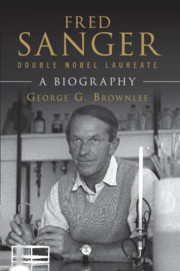Book contents
- Frontmatter
- Dedication
- Contents
- List of figures
- Foreword
- Acknowledgements and original sources
- Brief chronology
- Honours
- Introduction
- 1 A Quaker upbringing
- 2 How about studying insulin?
- 3 Radioactive sequencing of proteins and nucleic acids
- 4 Interview of Fred by the author in 1992: Early life
- 5 Interview of Fred by the author in 1992: Insulin and the Biochemistry Department, University of Cambridge
- 6 Interview of Fred by the author in 1992: Nucleic acids at the MRC Laboratory of Molecular Biology, Cambridge
- 7 Post-Sanger sequencing: high-throughput automated sequencing
- 8 Cancer: the impact of new-generation sequencing
- 9 Commentaries on Fred Sanger’s scientific legacy
- Epilogue
- Appendix: Complete bibliography of Fred Sanger
- Notes
- Index
- Plates
7 - Post-Sanger sequencing: high-throughput automated sequencing
Published online by Cambridge University Press: 05 November 2014
- Frontmatter
- Dedication
- Contents
- List of figures
- Foreword
- Acknowledgements and original sources
- Brief chronology
- Honours
- Introduction
- 1 A Quaker upbringing
- 2 How about studying insulin?
- 3 Radioactive sequencing of proteins and nucleic acids
- 4 Interview of Fred by the author in 1992: Early life
- 5 Interview of Fred by the author in 1992: Insulin and the Biochemistry Department, University of Cambridge
- 6 Interview of Fred by the author in 1992: Nucleic acids at the MRC Laboratory of Molecular Biology, Cambridge
- 7 Post-Sanger sequencing: high-throughput automated sequencing
- 8 Cancer: the impact of new-generation sequencing
- 9 Commentaries on Fred Sanger’s scientific legacy
- Epilogue
- Appendix: Complete bibliography of Fred Sanger
- Notes
- Index
- Plates
Summary
After Fred Sanger described his dideoxy sequencing method in 1977, the main technical innovation was the development of high-throughput automated methods that were not dependent on radioactivity. Autoradiography was replaced by the introduction of fluorescent ‘tags’ on short DNA ‘primers’ – one for each of the four dideoxy terminator reactions. The four dideoxy terminators – C, A, G and T – were distinguishable by the four different fluorescent tags on the primer used for the particular dideoxy terminator sequencing reaction. These tags were detected by lasers and a camera operating in real time monitoring the progress of the separation of the chain terminated reaction products during their separation by gel electrophoresis. The sequence was now recorded automatically. The raw sequence information was processed by suitable software programs on a computer and presented as a linear sequence. Thus Fred Sanger’s manual ‘read’ of radioactive bands on an autoradiograph of a gel was now replaced by an automated ‘read’ of fluorescent bands on the same type of gel.
Commercial machines using this technology soon became available and were first used by Craig Venter and colleagues in 1987. Subsequently there were further technical improvements to these machines optimising the matrix used for the electrophoretic separation of the chain terminated reaction products. Improvements were also made by positioning the fluorescent tag on the dideoxy terminating nucleotide. But these technical developments were still using the basic dideoxy sequencing method, the copying of a single-stranded template by primed synthesis with a DNA polymerase in the presence of dideoxy chain terminators, as devised by Fred Sanger in 1977.
- Type
- Chapter
- Information
- Fred Sanger - Double Nobel LaureateA Biography, pp. 136 - 145Publisher: Cambridge University PressPrint publication year: 2014



